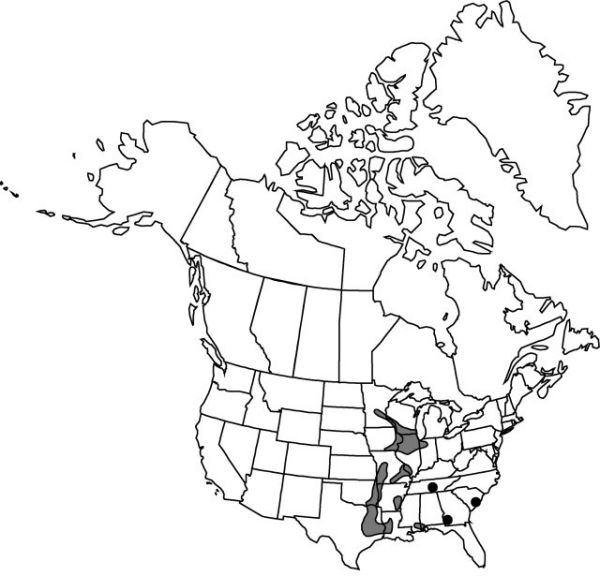Calopogon oklahomensis
Lindleyana 10: 37, figs. 1, 2. 1995.
Plants 11–35 cm. Corms elongate, forked, 18–29 mm. Leaves not appressed to inflorescences at flowering; blade linear-lanceolate, 7–35 cm × 5–15 mm. Inflorescences green, 11.8–34 cm; floral bracts ovate-lanceolate to subulate, 3–8 mm. Flowers 2–7(–11), more than 1 cm apart, opening nearly simultaneously, magenta, pink, to white, fragrant; dorsal sepal strongly spreading to straight, obovate to oblanceolate, 14–25 × 5–8 mm, apex acuminate or acute; lateral sepals strongly spreading to straight, ovate to broadly lanceolate, slightly falcate, 15–22 × 8–10 mm, apex acuminate to apiculate; petals slightly falcate to straight, oblong to obpandurate, 11–20 × 5–8 mm, apex obtuse; lip 10–17 mm, middle lobe with dilated apex triangular, broadly rounded, 5–12 mm wide, apex acute or retuse; column 8.5–13 × 1.5–2 mm, distal end 5–8.5 mm wide; rostellum present; stigma typically flat against column surface. 2n = 120.
Phenology: Flowering Mar–Jul.
Habitat: Mesic, acidic, sandy to loamy prairies, pine savannas, oak woodlands, edges of bogs, and frequently mowed meadows
Elevation: 0–300 m
Distribution

Ala., Ark., Ga., Ill., Ind., Iowa, Kans., La., Minn., Miss., Mo., Okla., S.C., Tenn., Tex., Wis.
Discussion
Calopogon oklahomensis originally was thought to be restricted to the south-central states; it is much more widespread. It is, however, nearly extirpated outside the south-central states. DNA evidence, as well as its hexaploid chromosome number, suggest that this species may be an alloploid, possibly derived from ancient hybridization between C. barbatus and C. tuberosus (D. H. Goldman 2000).